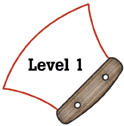|
National Science Education Standards
People have always had problems and invented tools and techniques (ways
of doing something) to solve problems. Trying to determine the effects
of solutions helps people avoid some new problems. (Page 138)
People continue inventing new ways of doing things, solving problems,
and getting work done. New ideas and inventions often affect other people;
sometimes the effects are good and sometimes they are bad. It is helpful
to try to determine in advance how ideas and inventions will affect other
people. (Page 140)
Science and technology have greatly improved food quality and quantity,
transportation, health, sanitation, and communication. These benefits
of science and technology are not available to all of the people in the
world. (Page 141)
|
|
Benchmarks
Tools are used to do things better or more easily and to do some things
that could not otherwise be done at all. In technology, tools are used
to observe, measure, and make things. (Page 44)
People, alone or in groups, are always inventing new ways to solve problems
and get work done. The tools and ways of doing things that people have
invented affect all aspects of life. (Page 54)
|

